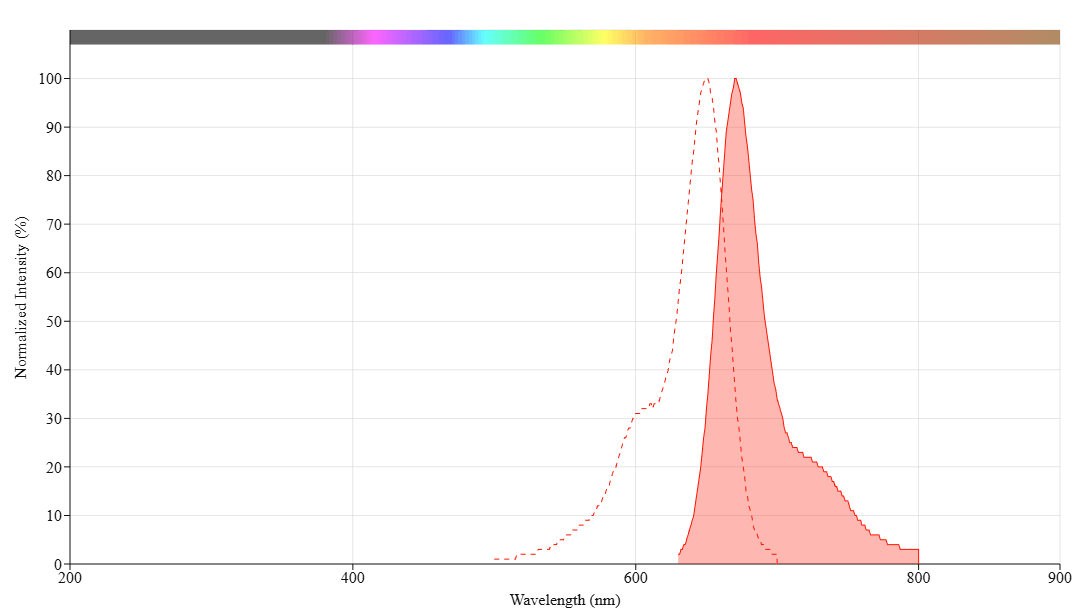XFD647 Alkyne
Product key features
- Ex/Em: 650/671 nm
- Extinction coefficient: 270,000 cm-1M-1
- Reactive Group: Alkyne
- Efficient Conjugation: Click chemistry labeling of azides on peptides, antibodies, and other biomolecules
- Bright & Stable: Delivers intense fluorescence with resilience to photobleaching and pH variations from 4 to 10
- Hydrophilic: Minimizes aggregation, enhancing signal clarity for advanced imaging and live-cell studies
Product description
XFD647, manufactured by AAT Bioquest, is a bright far-red flurosecent dye structurally identical to Alexa Fluor™ 647 (ThermoFisher). It is efficiently excited by the 594 nm or 633 nm laser lines and is compatible with RFP filters like Cy5, making it well-suited for applications such as fluorescence microscopy and flow cytometry. XFD647 exhibits excellent aqueous solubility and pH stability across a wide range (pH 4–10), ensuring robust signal reproducibility under diverse experimental conditions. The dye enables high-degree conjugation to biomolecules with minimal self-quenching, resulting in enhanced fluorescence intensity and signal stability. Additionally, its high fluorescence quantum yield and superior photostability facilitate the sensitive detection of low-abundance targets, enhancing precision and sensitivity in quantitative fluorescence-based assays.
The alkyne derivative of XFD647 is widely used for labeling azides on peptides, antibodies, and other biomolecules via click chemistry. It participates in copper-catalyzed azide-alkyne cycloaddition (CuAAC) with azide-containing molecules.
Spectrum
Product family
| Name | Excitation (nm) | Emission (nm) | Extinction coefficient (cm -1 M -1) | Correction Factor (260 nm) | Correction Factor (280 nm) |
| XFD488 alkyne *Same Structure to Alexa Fluor™ 488 alkyne* | 499 | 520 | 71000 | 0.30 | 0.11 |
| XFD555 alkyne | 553 | 568 | 150000 | 0.08 | 0.08 |
| XFD635 alkyne | 633 | 647 | 140,000 | - | - |
| XFD647 TCO | 650 | 671 | 239000 | 0.00 | 0.03 |
| XFD647 Tetrazine | 650 | 671 | 239000 | 0.00 | 0.03 |
| XFD680 alkyne | 681 | 704 | 184000 | 0.00 | 0.05 |
| XFD700 alkyne | 696 | 719 | 192000 | 0.00 | 0.07 |
| XFD750 alkyne | 752 | 776 | 240000 | 0.00 | 0.04 |
| XFD790 alkyne | 782 | 805 | 260,000 | 0.09 | 0.08 |
Show More (3) | |||||
References
Authors: Shen, Yuqian and Liu, Wenhua and Zuo, Jian and Han, Junhai and Zhang, Zi Chao
Journal: STAR protocols (2021): 100616
Authors: Troth, Emma V and Kyle, Dennis E
Journal: Antimicrobial agents and chemotherapy (2021): e0001721
Authors: Willén, Daniel and Mastio, Roberto and Söderlund, Zackarias and Manner, Sophie and Westergren-Thorsson, Gunilla and Tykesson, Emil and Ellervik, Ulf
Journal: Bioconjugate chemistry (2021): 2507-2515
Authors: Koch, Peter D and Quintana, Jeremy and Ahmed, Maaz and Kohler, Rainer H and Weissleder, Ralph
Journal: Advanced therapeutics (2021)
Authors: Daughtry, Jessica L and Cao, Wendy and Ye, Johnny and Baskin, Jeremy M
Journal: ACS chemical biology (2020): 318-324




